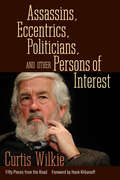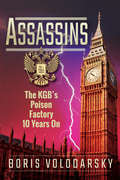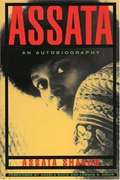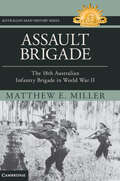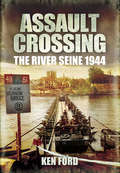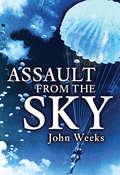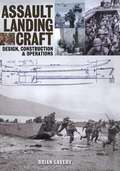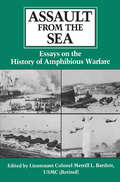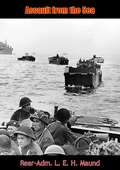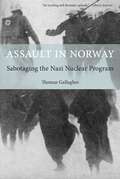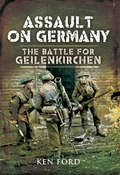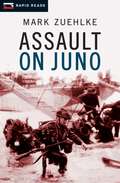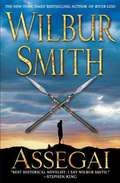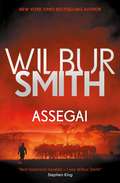- Table View
- List View
Assassins and Conspirators: Anarchism, Socialism, and Political Culture in Imperial Germany
by Elun GabrielOver the course of the German Empire the Social Democrats went from being a vilified and persecuted minority to becoming the largest party in the Reichstag, enjoying broad-based support. But this was not always the case. In the 1870s, government mouthpieces branded Social Democracy the "party of assassins and conspirators" and sought to excite popular fury against it. Over time, Social Democrats managed to refashion their public image in large part by contrasting themselves to anarchists, who came to represent a politics that went far beyond the boundaries of acceptable behavior. Social Democrats emphasized their overall commitment to peaceful change through parliamentary participation and a willingness to engage their political rivals. They condemned anarchist behavior—terrorism and other political violence specifically—and distanced themselves from the alleged anarchist personal characteristics of rashness, emotionalism, cowardice, and secrecy. Repeated public debate about the appropriate place of Socialism in German society, and its relationship to anarchist terrorism, helped Socialists and others, such as liberals, political Catholics, and national minorities, cement the principles of legal equality and a vigorous public sphere in German political culture. Using a diverse array of primary sources from newspapers and political pamphlets to Reichstag speeches to police reports on anarchist and socialist activity, this book sets the history of Social Democracy within the context of public political debate about democracy, the rule of law, and the appropriate use of state power. Gabriel also places the history of German anarchism in the larger contexts of German history and the history of European socialism, where its importance has often been understated because of the movement's small size and failure to create a long-term mass movement.
Assassins of the Turquoise Palace
by Roya HakakianOn the evening of September 17, 1992, eight leading members of the Iranian and Kurdish opposition had gathered at a little-known restaurant in Berlin when two darkly-clad men burst through the entrance. Within moments, the roar of a machine gun filled the air. Two rounds of fire and four single shots later, four of the men were dead. One of the survivors of that shooting, along with the widow of one of the victims and a handful of reporters, attorneys, and fellow exiles, began a crusade that would not only pit them against Tehran but against some of the greatest powers in Germany. When an undeterred federal prosecutor, and an endlessly patient chief judge, took over the case, a historic verdict followed which shook both Europe and Iran, and achieved something few could have predicted-justice. Roya Hakakian’s The Assassins of the Turquoise Palace is an incredible book of history and reportage, and an unforgettable narrative of heroism and justice.
Assassins, Eccentrics, Politicians, and Other Persons of Interest: Fifty Pieces from the Road
by Curtis WilkieWriting as a newspaper reporter for nearly forty years, Curtis Wilkie covered eight presidential campaigns, spent years in the Middle East, and traveled to a number of conflicts abroad. However, his memory keeps turning home and many of his most treasured stories transpire in the Deep South. He called his native Mississippi, “the gift that keeps on giving.” For Wilkie, it represented a trove of rogues and racists, colorful personalities and outlandish politicians who managed to thrive among people otherwise kind and generous. Assassins, Eccentrics, Politicians, and Other Persons of Interest collects news dispatches and feature stories from the author during a journalism career that began in 1963 and lasted until 2000. As a young reporter for the Clarksdale Press Register, he wrote many articles that dealt with the civil rights movement, which dominated the news in the Mississippi Delta during the 1960s.Wilkie spent twenty-six years as a national and foreign correspondent for the Boston Globe. One of the original “Boys on the Bus” (the title of a best-selling book about journalists covering the 1972 presidential campaign), he later wrote extensively about the winning races of two southern Presidents, Jimmy Carter and Bill Clinton. Wilkie is known for stories reported deeply, rife with anecdotes, physical descriptions, and important background details. He writes about the notorious, such as the late Hunter S. Thompson, as well as more anonymous subjects whose stories, in his hands, have enduring interest. The anthology collects pieces about several notable southerners: Ross Barnett; Byron De La Beckwith and Sam Bowers; Billy Carter; Edwin Edwards and David Duke; Trent Lott; and Charles Evers. Wilkie brings a perceptive eye to people and events, and his eloquent storytelling represents some of the best journalistic writing.
Assassins: A British Mystery Series Set In 1920s London (The Detective Chief Inspector Stark Mysteries #1)
by Jim EldridgeA professional assassin stalks London&’s streets in the first historical mystery featuring Scotland Yard&’s Detective Chief Inspector Stark. London, 1921. The Great War has recently ended and tensions in England are high. Now, prominent Cabinet minister Lord Amersham has been shot dead outside his Regent&’s Park home. With two bullets to the chest and one to the forehead, all signs point to a professional hit. Charged with solving one of the most sensitive and high-profile cases Scotland Yard has ever faced, DCI Paul Stark is under pressure to get the job done quickly. Amersham&’s colleague Winston Churchill, Secretary of State for the Colonies, is convinced the Bolsheviks are responsible. Stark&’s contemporaries at Special Branch believe there&’s a connection to Government talks about Irish Home Rule. And others believe the motive could be connected to Lord Amersham&’s rather scandalous private life . . . When a second crime takes place—another murder committed by an expert marksman at close range—the case takes a terrifying turn and puts Stark right in the middle of an international crisis. &“Besides providing interesting nuggets of history, Eldridge depicts his lead characters with complexity and compassion, auguring well for this series kickoff.&” —Kirkus Reviews
Assassins: The KGB's Poison Factory 10 Years On
by Boris VolodarskyA look at the events surrounding the 2006 poisoning of a former Russian security officer in Great Britain.In November, 1998, Alexander Litvinenko, a former lieutenant colonel of the Russian security service or FSB, along with several former colleagues, publicly stated that their superiors had instigated an assassination attempt on a Russian tycoon and oligarch. Following his subsequent arrest and failed trials, Litvinenko fled to London where, having been granted asylum, he worked as a journalist and writer, as well as acting as a consultant for the British intelligence services.Eight years later, Litvinenko’s past caught up with him when he was assassinated in London. On November 1, 2006, Litvinenko was suddenly taken ill and hospitalized. He passed away twenty-two days later. Significant amounts of a rare, highly toxic element were subsequently found in his body. Before his death, Litvinenko had said, “You may succeed in silencing one man, but the howl of protest from around the world, Mr. Putin, will reverberate in your ears for the rest of your life.”Author Boris Volodarsky, who was consulted by the Metropolitan Police during the investigation and remains in close contact with Litvinenko’s widow, details the events surrounding Litvinenko’s murder. Volodarsky updates the story, referring to the findings of the official British inquiry, on the release of which Prime Minister David Cameron condemned Putin for presiding over “state sponsored murder.”The author proves that the Litvinenko’s poisoning is just one of many. Some of these assassinations or attempted assassinations are already known; others are revealed by him for the first time.
Assassins: The KGB's Poison Factory 10 Years On
by Boris VolodarskyA look at the events surrounding the 2006 poisoning of a former Russian security officer in Great Britain.In November, 1998, Alexander Litvinenko, a former lieutenant colonel of the Russian security service or FSB, along with several former colleagues, publicly stated that their superiors had instigated an assassination attempt on a Russian tycoon and oligarch. Following his subsequent arrest and failed trials, Litvinenko fled to London where, having been granted asylum, he worked as a journalist and writer, as well as acting as a consultant for the British intelligence services.Eight years later, Litvinenko’s past caught up with him when he was assassinated in London. On November 1, 2006, Litvinenko was suddenly taken ill and hospitalized. He passed away twenty-two days later. Significant amounts of a rare, highly toxic element were subsequently found in his body. Before his death, Litvinenko had said, “You may succeed in silencing one man, but the howl of protest from around the world, Mr. Putin, will reverberate in your ears for the rest of your life.”Author Boris Volodarsky, who was consulted by the Metropolitan Police during the investigation and remains in close contact with Litvinenko’s widow, details the events surrounding Litvinenko’s murder. Volodarsky updates the story, referring to the findings of the official British inquiry, on the release of which Prime Minister David Cameron condemned Putin for presiding over “state sponsored murder.”The author proves that the Litvinenko’s poisoning is just one of many. Some of these assassinations or attempted assassinations are already known; others are revealed by him for the first time.
Assata: An Autobiography
by Angela Y. Davis Assata Shakur Lennox S. HindsOn May 2, 1973, Black Panther Assata Shakur (aka JoAnne Chesimard) lay in a hospital, close to death, handcuffed to her bed, while local, state, and federal police attempted to question her about the shootout on the New Jersey Turnpike that had claimed the life of a white state trooper. Long a target of J. Edgar Hoover's campaign to defame, infiltrate, and criminalize Black nationalist organizations and their leaders, Shakur was incarcerated for four years prior to her conviction on flimsy evidence in 1977 as an accomplice to murder. This intensely personal and political autobiography belies the fearsome image of JoAnne Chesimard long projected by the media and the state. With wit and candor, Assata Shakur recounts the experiences that led her to a life of activism and portrays the strengths, weaknesses, and eventual demise of Black and White revolutionary groups at the hand of government officials. The result is a signal contribution to the literature about growing up Black in America that has already taken its place alongside The Autobiography of Malcolm X and the works of Maya Angelou. Two years after her conviction, Assata Shakur escaped from prison. She was given political asylum by Cuba, where she now resides.
Assault Brigade: The 18th Australian Infantry Brigade in World War II (Australian Army History Series)
by Matthew MillerThe Australian Army served in numerous theatres and campaigns throughout World War II, earning distinction and at times facing significant challenges. During the Pacific War, the infantry brigade, as an intermediate formation commanding multiple infantry battalions and numerous attached units, was key in Australian efforts to secure victory. The 18th Infantry Brigade participated in a variety of combat operations with a range of allies allowing it rare experience among Australian units. It's involvement in operations from Europe to the Middle East and onto the Pacific ensured that it was one of the most modern brigades at the close of the war. Assault Brigade examines the challenges and development of the Australian Army's 18th Infantry Brigade throughout World War II. It investigates a series of campaigns fought across the South West Pacific Area, highlighting lessons learnt and adaptations implemented as a result of each battle.
Assault Crossing: The River Seine 1944
by Ken FordThe assault crossing of the River Seine by the British 43rd (Wessex) Division in August 1944 remains one of the most important operations of the closing stages of the Second World War. Once the obstacle of the great river had been overcome, General Horrocks unleashed the armor of XXX Corps on their historic dash across northern France and Belgium.Assault Crossing Ken Fords classic account of this critical battle—is the story of one British division pitted against one German division. On one side, a fully equipped, battle-hardened unit made up of soldiers from the ancient Kingdom of Wessex, backed by some of the best artillery in the world and supported by tanks. On the other side, a much-depleted, second-rate, static division of men of various nationalities conscripted to fight a war for Germany that was already lost. On paper the British were assured of success, but between the two opposing armies lay the Seine 680 feet of open water, overlooked by high chalk cliffs riddle with defensive strong points. The Germans were waiting.In hindsight, the battle was described as an epic operation and used as an example to train future generations of soldiers. In reality, as with most battles, it was something of a shambles, lurching from crisis to crisis until the eventual bridgehead was secured.In his graphic narrative Ken Ford gives a fascinating insight into the planning of the operation and the confusion of the battlefield, and he records, using eyewitness testimony, what the battle was really like for the soldiers who were there.
Assault From the Sky: The History of Airborne Warfare 1939-1980s
by John WeeksEx paratrooper John Weeks' exciting eBook is a dramatic history of airborne troops and their most famous actions: Crete, Arnhem, D-Day, the Vietnam War and beyond.Airborne raids caught popular imagination early in the Second World War, when the elite German forces carried out deadly operations deep behind enemy lines. Able to seize and hold objectives before the enemy has time to react, paratrooper assaults were seen as fast, dynamic and potentially devastating. However, they are also unpredictable. Requiring complete surprise, tactical flexibility and a lot of luck to succeed, a daring airborne raid can soon turn into a disaster, as the Allies discovered in Operation Market Garden. Studying the evolution of airborne forces over one of the bloodiest eras in world history, Assault from the Sky looks at the planners, the generals, aircraft, gliders, weapons and the men who created a revolution in modern warfare.
Assault Landing Craft: Design, Construction & Operators
by Brian LaveryThe landing craft assault or LCA was one of the unsung heroes of the Second World War. It took part in practically every amphibious operation from Norway to Normandy and landed around 400,000 men in action conditions, plus many more in training. It was the only serviceable British landing craft at the beginning of the War, and it remained in service until the Suez operation of 1956. It landed the first waves of infantry on the British and Canadian beaches in Normandy in 1944, and Americans on the notorious Omaha Beach. Its far-sighted design of 1938 remains the basis for the landing craft of today.This is the first book devoted to this humble but essential craft. It examines its design history before the War, when amphibious operations were deeply unfashionable. It describes its design and construction with plans that will be useful to modellers and wargamers. It includes information on the role of the crew and the techniques and tactics used in landings. It gives an account of the larger ships which carried it and the life of the sailors and soldiers who travelled in it, with many vivid personal accounts. Finally, it describes its role in the many operations in which it took part, including withdrawals such as Dunkirk and the catastrophic Dieppe raid of 1942.
Assault at West Point, The Court Martial of Johnson Whittaker
by John MarszalekIn "Assault at West Point", John F. Marszalek, the highly acclaimed author of "Sherman: A Soldier's Passion for Order", has written a dramatic account of one of the most momentous trials in American history. Set in the 1880s, this riveting story focuses on Whittaker, a former slave who became the third black to enter West Point. Like his two predecessors, he was ostracized for the entire three years of his training. One morning Whittaker didn't show up for drill. He was found in his room, unconscious, tied tightly to the bed, with blood streaming from his head. In a trial that received major attention from the press, Whittaker was accused of faking the crime to get sympathy from the public and from his professors. Author Marszalek weaves his rich narrative from historical records to tell how Whittaker sought justice against all odds. Now the basis if the Showtime original movie "Assault at West Point", this compelling work brings to life a case that rocked the country and involved the highest reaches of power-- and vividly demonstrates the impact of racism on the fabric of American society.
Assault at West Point: The Court Martial of Johnson Whittaker
by John F. MarszalekIn "Assault at West Point", John F. Marszalek, the highly acclaimed author of "Sherman: A Soldier's Passion for Order", has written a dramatic account of one of the most momentous trials in American history. Set in the 1880s, this riveting story focuses on Whittaker, a former slave who became the third black to enter West Point. Like his two predecessors, he was ostracized for the entire three years of his training. One morning Whittaker didn't show up for drill. He was found in his room, unconscious, tied tightly to the bed, with blood streaming from his head. In a trial that received major attention from the press, Whittaker was accused of faking the crime to get sympathy from the public and from his professors. Author Marszalek weaves his rich narrative from historical records to tell how Whittaker sought justice against all odds. Now the basis if the Showtime original movie "Assault at West Point", this compelling work brings to life a case that rocked the country and involved the highest reaches of power-- and vividly demonstrates the impact of racism on the fabric of American society.
Assault from the Sea
by Merrill L. BartlettThis collection of 51 essays provides a history of amphibious landings that include European, Asian, and American operations. It describes in detail some of history's most significant amphibious assaults, as well as planned attacks that were never carried out.
Assault from the Sea
by Rear-Adm. L. E. H. MaundAssault from the Sea, first published in 1949, is Rear-Admiral Maund’s account of the development of the Royal Navy’s landing craft and their use operationally between 1939 and 1945.“It is the purpose of this book to show how this knowledge and equipment were gradually collected. It starts in the days before the last war, when most people thought landing operations would be impossible, and traces their development to the days of the great awakening at Dunkirk and on to present times. It shows how developments in material, tactics and planning were evolved by original thought, training, planning operations and experiments and it indicates the influence of political and strategic considerations upon this development.”—Preface
Assault from the Sky: Marine Corps Helicopter Operations in Vietnam
by Dick Camp&“Action-packed . . . he brings the reader artfully through the fog of war with clarity&” (20th Century Aviation Magazine). Vietnam has often been called our &“first helicopter war,&” and indeed, the US Marine Corps, as well as Army, had to feel its way forward during the initial combats. But by 1967, the combat was raging across South Vietnam, with confrontational battles against the NVA on a scale comparable to the great campaigns of WWII. In 1968, when the Communists launched their mammoth counteroffensive, the Marines were forced to fight on all sides, with the helicopter giving them the additional dimension that proved decisive in repelling the enemy. The author of this book, a Vietnam veteran and Purple Heart recipient who has also worked at the USMC History Division and National Museum of the Marine Corps in Quantico, uses his experiences as a company commander to bring the story to life by weaving personal accounts, after-action reports, and official documents into a compellingly readable narrative of service and sacrifice by Marine pilots and crewmen. The entire story of the war is depicted through the prism of Marine helicopter operations, from the first deployments to support the Army of the Republic of Vietnam against the Viet Cong through the rapid US buildup to stop the North Vietnamese Army, until the final withdrawal from our Embassy. &“Superlative research.&” —Leatherneck
Assault in Norway: Sabotaging The Nazi Nuclear Program
by Thomas Gallagher&“An exciting and dramatic episode.&”—Library Journal&“Cliff-hanging suspense.&”—Christian Science Monitor Assault in Norway is the classic account of a legendary raid on the Nazi war program. By 1942 Germany had a seemingly insurmountable lead over the Allies in developing an atomic bomb. Contributing to this situation was its access to a crucial ingredient: &“heavy water,&” found in great abundance at a fortresslike factory in occupied Norway. Allied hopes of stalling the Nazi nuclear program soon focused on sabotaging the cliffside plant—a suicidal mission. But a team of brave Norwegian exiles, trained in Britain, infiltrated their homeland and, hiding in the wilds, awaited the opportunity to launch one of the war&’s most daring commando raids. Basing his gripping narrative in large part on interviews with the commandos themselves, Thomas Gallagher recounts in vivid detail the planning and execution of Operation Gunnerside. Assault in Norway recalls the intrigue found in such wartime classics as David Howarth&’s We Die Alone and The Sledge Patrol, and the mission it recounts inspired the 1965 Hollywood film The Heroes of Telemark.
Assault of the Mountain Man (Mountain Man #39)
by William W. Johnstone J.A. JohnstoneUSA Today bestselling author: With a gun, a badge, and a thirst for vengeance, Smoke Jensen goes after a band of brutal bank robbers . . .Smoke Jensen stands as a force of will in the lawless west. Messing with his wife is a bad idea . . .Into the Valley of DeathSally has traveled to the silver-mining town of Goth, Colorado, to open a restaurant with a friend. That's where she crosses paths with five bank robbers in a hurry to strike it rich. With the local sheriff lying dead in a pool of blood, Sally fights for her life while a frontier surgeon tries to work a miracle.Burning with fury, armed with a gun and a badge, Smoke Jensen goes on the hunt—a posse of one against a gang of outlaws more dangerous than he can know. Soon, Smoke is being lured into a trap at a place called Black Canyon—a deep, dark valley of death, from which only one man will emerge alive . . .
Assault on Germany: The Battle for Geilenkirchen
by Ken FordThe author of A Luftwaffe General gives a detailed history of the Allied forces&’ brutal Operation Clipper during World War II. The Anglo-American battle for the Geilenkirchen salient in November, 1944, was infantry warfare at its worst, and it is described in vivid detail in this new edition of Ken Ford&’s classic study. The onset of winter saw the Allied advance from the Normandy beaches forced to a halt on Germany&’s doorstep. The clock had been put back to the days of the Great War—the Allies had arrived at the Siegfried Line and were forced to attack the fortifications from the hell of the trenches. Geilenkirchen was the first battle on German soil to be fought by the British since Minden in 1759. For them, it was just one more battle on the way to Berlin, but for the American 84th Division, it was a first faltering step into war and a bitter lesson in the attrition and savagery of combat. The story is told by the men who were there—the British, the Americans, and the Germans who were fighting desperately for their homeland. Neither side was victorious—both lost more men than they could afford and paid a heavy price in young lives for a few miles of ground.
Assault on Juno (Rapid Reads)
by Mark ZuehlkeDawn, June 6, 1944. Off the Normandy coast 6,500 ships carry 150,000 Allied troops. This is D-Day, the long-awaited Allied invasion of German-occupied Europe. The Allies will storm five beaches. One is code-named Juno Beach. Here, 14,500 Canadians will land on a five-mile stretch of sand backed by three resort towns. The beach is heavily protected by a seawall, barbed wire, underwater obstacles and hundreds of mines. Behind these defenses a heavily armed German force waits inside thick concrete pillboxes and deep trenches that bristle with machineguns and artillery pieces. About 3,500 Canadians will lead the way. The fate of the invasion is in their hands. They either break the German defenses or die trying. Piling out of small, frail landing craft, they struggle through bullet- and shell-whipped water to gain the sand. And the bloody battle for Juno Beach begins. With his trademark you-are-there style, acclaimed military historian Mark Zuehlke plunges readers into a vivid and powerful account of the day-long battle that put the Allies on the march toward victory in World War II.
Assaults from the Sky: Assaults From The Sky (Air War D-Day #2)
by Martin W. BowmanThis is the second volume of a comprehensive five part work on D-Day that includes a multitude of personal military accounts from both Allied and German Aviation personnel who were there. Overlord began with an assault by more than 23,000 airborne troops, 15,500 of them American, behind enemy lines to soften up the German troops and to secure key objectives. 6,600 paratroopers of the US 101st Screaming Eagles Division in 633 C-47s and 83 gliders and 6,396 paratroopers of the US 82nd All American Division in 1,101 C-47s and 427 gliders were dropped over the neck of the Cotentin peninsula. By the end of the operation, the list of casualties was extensive. But 101st Airborne Division linked up with the US 4th Infantry Division beach landings at Pouppeville, the most southerly exit off Utah Beach and the 82nd secured the area north of Ste-Mre-glise after fierce fighting and drove the enemy north, considerably delaying the German 243rd Infantry Division from contacting the Allied beach assault force. This important episode within the wider history of D-Day is enlivened in classic Bowman fashion, featuring both extensive historical notes as well as deeply personal accounts of endurance and individual gallantry.
Assedio del Cuore (Romanticismo della Guerra del Sud #2)
by Lexy TimmsKnox Township, 1863 Assedio del Cuore, Libro 2 della serie Romanticismo Merdionale, dell'autrice di best seller Lexy Timms. Jasper Perry ha una casa, una famiglia - tutto quello che lui pensava fosse perso per sempre dopo l'inizio della guerra.Con l'amore di Clara, Jasper crede di avere tutto quello che voleva. Mentre aspetta di sposarsi con Clara, lui scopre di aver6e superato la nostelgia di casa. Quando una milizia Confederata lo rapisce, determinato a punirlo per la sua defezione, Jasper ha una scelta: rinunciare alla lealtà che una volta aveva nei confronti della Confederazione e combattere per tornare indietro da Clara; oppure lasciare la sua nuova casa alle spalle, per tornare verso tutto ciò che è familiare. Per rendere le cose più complicate, la milizia ha scambiato Cecelia per la moglie di Jasper, e l'ha rapita. Riunito con la sua famiglia, Solomon Dalton tenta di ritornare alla sua vecchia vita come se nulla fosse accaduto. Ma quando Jasper e Cecelia sono rapiti, Solomon deve ritornare nel territorio della Confederazione per salvare le persone che ama. Ad ogni modo, lui non è solo, un uomo strano lo sta seguendo, e Solomon ha udito sottoforma di calmi sussurri che spie dell'Unione stanno cercando le persone che hanno tradito la causa...
Assegai
by Wilbur SmithWilbur Smith has won acclaim worldwide as the master of the historical novel. Now, in Assegai he takes readers on an unforgettable African adventure set against the gathering clouds of war. It is 1913 and Leon Courtney, an ex-soldier turned professional hunter in British East Africa, guides the rich and powerful from America and Europe on big-game safaris. Leon had never sought fame, but an expedition alongside U.S. President Theodore Roosevelt has made him one of the most sought-after hunters on the continent. Soon, he finds that with celebrity comes not just wealth--but also danger. Leon is recruited by his uncle Penrod Ballantyne, commander of the British forces in East Africa, to gather information on one of his clients: Count Otto von Meerbach, a German industrialist whose company builds aircraft and vehicles for the Kaiser's burgeoning army. While spying, Leon falls desperately in love with von Meerbach's beautiful and enigmatic mistress, Eva von Wellberg. On the eve of the World War, Leon stumbles on a plot by Count von Meerbach that could wipe out the British forces in Africa. He finds himself left alone to frustrate von Meerbach's plan, and in grave peril as he learns more about the enigmatic Eva. Set amidst the tensions that will spark a war across continents, Assegai delivers the fast-paced action and vivid history that has made Wilbur Smith an internationally bestselling author.
Assegai: The Courtney Series 13 (The Courtney Series: The Assegai Trilogy #1)
by Wilbur SmithA Courtney series adventure - Book 1 in the Assegai sequenceFor King and Country. No matter the cost. With the backing of his uncle, General Penrod Ballantyne, young Leon Courtney joins the King's Rifles of Nairobi. When he becomes discouraged by the dishonesty of army life, his uncle recruits him for a special mission - spying on the Germans in East Africa, whom the General suspects are preparing for the Kaiser's war. Posing as a professional game hunter Leon is tasked with gathering information on one is his clients, a wealthy industrialist Otto Von Meerbach. Leon finds himself falling for von Meerbach's beautiful mistress but never forgets that his real mission is to destroy the enemy. But how easy will he find his task when his true enemy is closer to home than Leon ever expected?
Assembled for Use: Indigenous Compilation and the Archives of Early Native American Literatures (The Henry Roe Cloud Series on American Indians and Modernity)
by Kelly WisecupA wide-ranging, multidisciplinary look at Native American literature through non-narrative texts like lists, albums, recipes, and scrapbooks &“An intricate history of Native textual production, use, and circulation that reshapes how we think about relationships between Native materials and settler-colonial collections.&”—Rose Miron, D&’Arcy McNickle Center for American Indian and Indigenous Studies at the Newberry Library Kelly Wisecup offers a sweeping account of early Native American literatures by examining Indigenous compilations: intentionally assembled texts that Native people made by juxtaposing and recontextualizing textual excerpts into new relations and meanings. Experiments in reading and recirculation, Indigenous compilations include Mohegan minister Samson Occom&’s medicinal recipes, the Ojibwe woman Charlotte Johnston&’s poetry scrapbooks, and Abenaki leader Joseph Laurent&’s vocabulary lists. Indigenous compilations proliferated in a period of colonial archive making, and Native writers used compilations to remake the very forms that defined their bodies, belongings, and words as ethnographic evidence. This study enables new understandings of canonical Native writers like William Apess, prominent settler collectors like Thomas Jefferson and Henry Rowe Schoolcraft, and Native people who contributed to compilations but remain absent from literary histories. Long before current conversations about decolonizing archives and museums, Native writers made and circulated compilations to critique colonial archives and foster relations within Indigenous communities.


